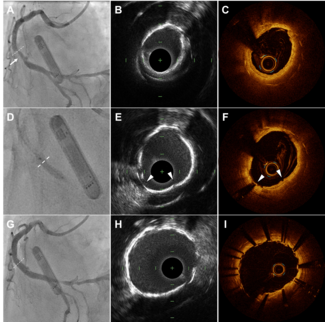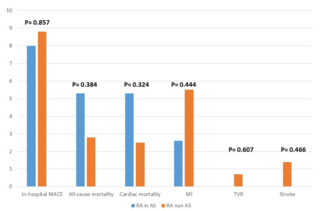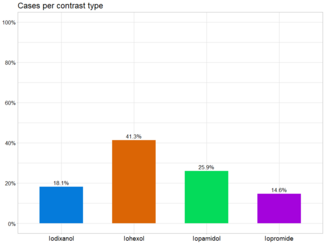Case Report
Selective Coronary Artery Fistula Embolization with Hystoacryl During Percutaneous Coronary Angioplasty<br />
February 2003
Coronary artery fistulae (CAF) are anomalous communications between coronary arteries and a cardiac chamber, great vessel or other vascular structure bypassing the myocardial capillary bed.1,2 The frequency has been reported to be approximately 0.2% of the adult population that has been subject to coronary angiography.3 CAF are usually congenital in origin, although they can rarely be acquired, either after coronary artery bypass grafting, mitral valve replacement4,5 or endomyocardial biopsy procedures.6
The clinical importance of CAF varies depending on the magnitude of the arteriovenous shunt. Small fistulae may not produce symptoms; however, larger fistulae may frequently be associated with exertional dyspnea or myocardial ischemia due to a “coronary steal” phenomenon.7,8 Uncommon complications, such as bacterial endocarditis,9,10 rupture9,11 and arrhythmia,12,13 have also been reported.
In the current report, we present two cases of coronary fistulae draining into the main pulmonary artery, one originating from the left anterior descending (LAD) coronary artery and the other from both the LAD and circumflex arteries. Both cases were successfully treated with selective embolization of hystoacryl (Isobutyl 2-Cyanocrylate). Percutaneous coronary transluminal angioplasty (PTCA) for atherosclerotic obstructive lesions was performed during the same procedure in both cases.
Hystoacryl is a substance that instantly polymerizes on contact with the blood’s ionic components, forming a solid “cap” that adheres to the vascular endothelium, occluding the vascular lumen instantaneously and permanently, without producing systemic hystotoxicity.14 Before selective embolization is performed, hystoacryl is prepared half-mixed with oleaginous contrast material and tungsten powder. This mixture allows its opacification and visualization by fluoroscopy during the procedure.
The guiding catheter used for the procedure is the same one used for PTCA and stent implantation. The selected guidewire was the 0.010´´ Transend with hydrophilic tip (Boston Scientific/Scimed, Inc., Maple Grove, Minnesota). A Spinnaker catheter (Target Therapeutics, Boston Scientific/Scimed, Inc.) was used for hystoacryl injection. This single-lumen catheter has a distal luminal diameter of 0.013´´. Its properties include great flexibility, which allows excellent navigability in tortuous vascular segments; it also has a distal radio-opaque marker that allows the exact location of the catheter in the vascular segment to be treated. The Spinnaker catheter is advanced over the Transend guidewire once the latter has been advanced well beyond the origin of the fistula, as distal as possible. The Spinnaker catheter is then advanced toward the vascular segment to be treated. Injection of contrast material through the internal lumen of the Spinnaker catheter is possible in order to exactly locate the segment in which the embolization should take place. Just before the hystoacryl injection is performed, the Transend guidewire is withdrawn and the internal lumen of the Spinnaker catheter must be flushed with a manual injection of 5% dextrose solution to avoid the possibility of occlusion of the internal lumen when hystoacryl is being injected, since this polymeric substance solidifies instantly in contact with the blood’s ionic components.
Hystoacryl embolization is performed manually with a 3 ml syringe. The embolization material can be visualized under fluoroscopy while being injected. It is extremely important to rapidly withdraw the Spinnaker catheter from the vascular segment after finishing the injection in order to avoid the obstruction and the adhesion of its distal tip at the fistulous path due to the instantaneous polymerization of hystoacryl upon contact with the bloodstream.
Case Report. Patient #1. A 53-year-old male with diabetes mellitus and chronic renal failure presented 2 years prior with dyspnea and progressive angina. There was no evidence of ischemia on the electrocardiogram (ECG); however, the myocardial perfusion scan showed anterolateral wall ischemia. Coronary angiography showed a primary 3-mm diameter CAF, which started in the proximal segment of the first diagonal branch with several secondary afferent pathways that drained into the main pulmonary artery (Figure 1A), and a long atherosclerotic lesion in the mid segment of the first diagonal branch was also observed (Figure 1B). Ejection fraction was calculated as 73%. Left coronary artery cannulation was performed with a 7 French (Fr) left Judkins catheter; 10,000 U of intravenous heparin were administered. The Transend guidewire was advanced deeply into the primary CAF pathway. The Spinnaker catheter was then advanced over the guidewire toward the half portion of the main afferent vascular segment of the fistula. The exact location for embolization was assessed by the distal marker of the Spinnaker catheter and visualization of the vascular pathway by contrast dye injection through the internal lumen of the catheter (Figure 1C).
Prior to embolization, the distal tip of the Spinnaker catheter was lodged at an approximate distance of 10 mm from the origin of the fistula. Two 3 ml injections of hystoacryl were performed (a new catheter for each embolization) at the proximal and mid portions of the main vascular afferent path of the fistula. Immediate closure of the fistula was demonstrated in a control angiogram as well as by the presence of a hystoacryl radioopacity “cap” at the treated site (Figure 1D). Afterward, PTCA of the critical lesion at the first diagonal branch was performed, using a 0.014´´ guidewire and 2.0 x 30 mm Gemini balloon catheter (Guidant Corporation, Temecula, California). Residual stenosis was 20% (Figure 1E). The patient was discharged after 3 days with aspirin, clopidogrel and amlodipine. At 10-month follow-up examination, the patient was symptom free.
Patient #2. A 51-year-old male with a history of dyspnea and atypical chest pain, a positive exercise treadmill test and a myocardial perfusion scan that showed inferior wall ischemia was referred for coronary angiography. A 90% stenosis at the distal segment of the circumflex (CX) artery was seen as well as a large arteriovenous fistula originating from the proximal segment of the LAD (Figure 2A). Several afferent branches filled to form a big aneurysmatic “collecting bag” that drained into the main pulmonary artery. Other small afferent fistulous pathways were observed to originate from the proximal segment of the CX, also draining into the previously described “collecting bag” (Figure 2B). Prior to the procedure, 10,000 U of heparin were given by intravenous infusion. First, embolization of the fistula with hystoacryl was performed using a 7 Fr Judkins left guiding catheter and a Spinnaker catheter advanced over a 0.010´´ Transend guidewire. The system was introduced into the fistulous pathway toward the main afferent vascular segment that drained into the “collecting bag”, with the tip of the Spinnaker catheter placed approximately 12–18 mm distal to the fistula origin (Figure 2C). Three injections were performed in the distal, mid and proximal segments (using a new Spinnaker catheter for each embolization) with 3 ml of hystoacryl for each embolization. At this point, angiography showed disappearance of two secondary afferent vascular segments that drained into the “collecting bag”; however, there was still moderate visualization of the fistula. Therefore, two more hystoacryl embolizations were performed in a selective manner into the afferent vascular branches that originated at the CX to completely obliterate the arteriovenous fistula (Figure 2D). Following embolization of the fistula, balloon angioplasty of the distal circumflex artery lesion was performed using the same guiding catheter; a 3.0 x 9 mm NIR Primo stent (Boston Scientific/Scimed, Inc.) was successfully implanted. At 8-month follow-up, the patient remained free of any cardiovascular symptoms.
Discussion. In the last two decades, the treatment of coronary artery fistulae has involved diverse percutaneous techniques that have been successful for afferent fistulous pathway closure. Widely used techniques include coil placement, application of small detachable balloons, double-umbrella devices,15 microparticle embolization16 and even covered stents.17 The current report describes a novel technique previously described in a case of CAF that originated at the LAD and drained into the main pulmonary artery.18 This technique allows the selective occlusion of different fistulous pathways draining into either a “collecting bag” or venous vascular segments of the fistula. Embolization is carried out by means of manual injection through a single-lumen catheter with a polymer (hystoacryl) that undergoes instantaneous solidification in contact with the bloodstream causing permanent occlusion of the vascular lumen. Embolization with hystoacryl is not a novel method; it was described in the early 1970s for the closure of some aortic-pulmonary communications.19 Other authors endorse its successful application for the treatment of arteriovenous fistulae in other territories (especially brain vascular territory).20,21 Embolization of distal secondary branches of mesenteric arteries in patients with gastrointestinal hemorrhage has also been reported.22
Considering the method’s characteristics, as well as the use of very low-profile and easy-to-navigate catheters, selective embolization with hystoacryl can have a potential application in CAF that possess several afferent fistulous pathways with small vascular diameters and extreme tortuosity. Because coils and detachable balloons usually have to be delivered by selective cannulation of the fistula with 3 Fr catheters, the probability of success in cases of multiple small fistulous pathways with such devices is reduced.
During the procedure, the following steps must be carefully followed: 1) it is very important to introduce the embolization catheter at least 10 mm into the initial segment of the fistulous pathway when hystoacryl injection is taking place in order to avoid hystoacryl reflux into the epicardial coronary artery where the fistula originates; 2) it is necessary to rapidly and accurately withdraw the embolization catheter at the end of each hystoacryl injection to avoid immediate adhesion of the catheter tip to the vascular endothelial wall, as this would carry the danger of rupture and retention of the distal portion of the catheter within the fistulous pathway.
It is worth mentioning that both PTCA and fistula embolization can be performed consecutively using the same guiding catheter. On the other hand, a potential disadvantage of this method is the inability to totally occlude fistulous pathways with large vascular diameters (probably more than 3 mm). In such cases, the embolization material could insufficiently occlude the vascular lumen.
We conclude that CAF hystoacryl embolization, in spite of limited experience with its use, could be a method that is adequate for the treatment of fistulae with multiple afferent pathways and small vascular diameters. In addition, this technique can be useful as a complement to traditional devices (coils and detachable balloons) used in the percutaneous approach for coronary artery fistula closure.
1. Angelini P. Normal and anomalous coronary arteries. Definition and classification. Am Heart J 1989;117:418–434.
2. Sapin P, Frantz E, Jain A, et al. Coronary artery fistulas: An abnormality affecting all age groups. Medicine 1990;69:101–113.
3. Baltaxe HA, Wixson D. The incidence of congenital anomalies of the coronary arteries in the adult population. Radiology 1977:47–52.
4. Said SA, Lindman GH. Coronary-pulmonary fistula. Long-term follow-up in operated and non-operated patients. Int J Cardiol 1990;27:203–210.
5. Gillebert C, Van Hoof R, Van De Werf F, et al. Coronary artery fistulae in an adult population. Eur Heart J 1986;7:437–443.
6. Sandhu J, Uretsky B, Zerbe T, et al. Coronary artery fistula in the heart transplant patient. A potential complication of endomyocardial biopsy. Circulation 1989;79:350–356.
7. Levin DC, Fellows KE, Abrams HL. Hemodynamically significant primary anomalies of the coronary arteries. Angiographic aspects. Circulation 1978;58:25–34.
8. Oshiro K, Shimabukuro M, Nakada Y, et al. Multiple coronary LV fistulas: Demonstration of coronary steal phenomenon by stress thallium scintigraphy and exercise hemodynamics. Am Heart J 1990;120:217–219.
9. Wilde P, Watt I. Congenital coronary artery fistulae: Six new cases with a collective review. Clin Radiol 1980;31:301–311.
10. McNamara JJ, Gross RE. Congenital coronary artery fistula. Surgery 1969;65:59–69.
11. Liberthson RR, Sagar K, Berkoben JP, et al. Congenital coronary arteriovenous fistula: Report of 13 patients, review of the literature and delineation of management. Circulation 1979;59:849–854.
12. Reidy JF, Anjos RT, Qureshi SA, et al. Transcatheter embolization in the treatment of coronary artery fistulas. J Am Coll Cardiol 1991;18:187–192.
13. Hguyen K, Myler RK, Hieshima G, et al. Treatment of coronary artery stenosis and coronary arteriovenous fistula by interventional cardiology techniques. Cathet Cardiovasc Diagn 1989;18:240–243.
14. Vinters HV, Lundie MJ, Kaufmann JC. Long-term pathological follow-up of cerebral arteriovenous malformations treated by embolization with bucrylate. N Engl J Med 1986;314:477–483.
15. Perry SB, Rome J, Keane JF, et al. Transcatheter closure of coronary artery fistulas. J Am Coll Cardiol 1992;20:205–209.
16. Strunk BL, Hieshima GB, Shafton EP. Treatment of congenital coronary arteriovenous malformations with micro-particle embolization. Cathet Cardiovasc Diagn 1991;22:133–136.
17. Dorros G, Venkat T, Ramireddy K, Joseph G. Catheter-based techniques for closure of coronary fistulae. Cathet Cardiovasc Intervent 1999;46:143–150.
18. Vajifdar BU, Lokhandwala YY, Kerkar PG, et al. Transcatheter glue occlusion of bilateral coronary-pulmonary arterial fistulae. Indian Heart J 1999;51:209–211.
19. Zuberbuhler JR, Dankner E, Zoltum R, et al. Tissue adhesive closure of aortic-pulmonary communications. Am Heart J 1974;88:41–46.
20. Samson D, Ditmore QM, Beyer CW Jr. Intravascular use of isobutyl 2-cyanocrilate. Treatment of intracranial arteriovenous malformations. Neurosurgery 1981;8:43–51.
21. Debrum GM, Aletich V, Ausman JI, et al. Embolization of the nidus of brain arteriovenous malformations with n-butyl cyanocrylate. Neurosurgery 1997;40:112–120.
22. Freeny PC, Mennemeyer R, Kidd R, Bush WH. Long-term radiographic-pathologic follow-up of patients treated with visceral transcatheter occlusion using isobutyl 2-cyanocrylate (Bucrylate). Radiology 1979;132:51–60.


















